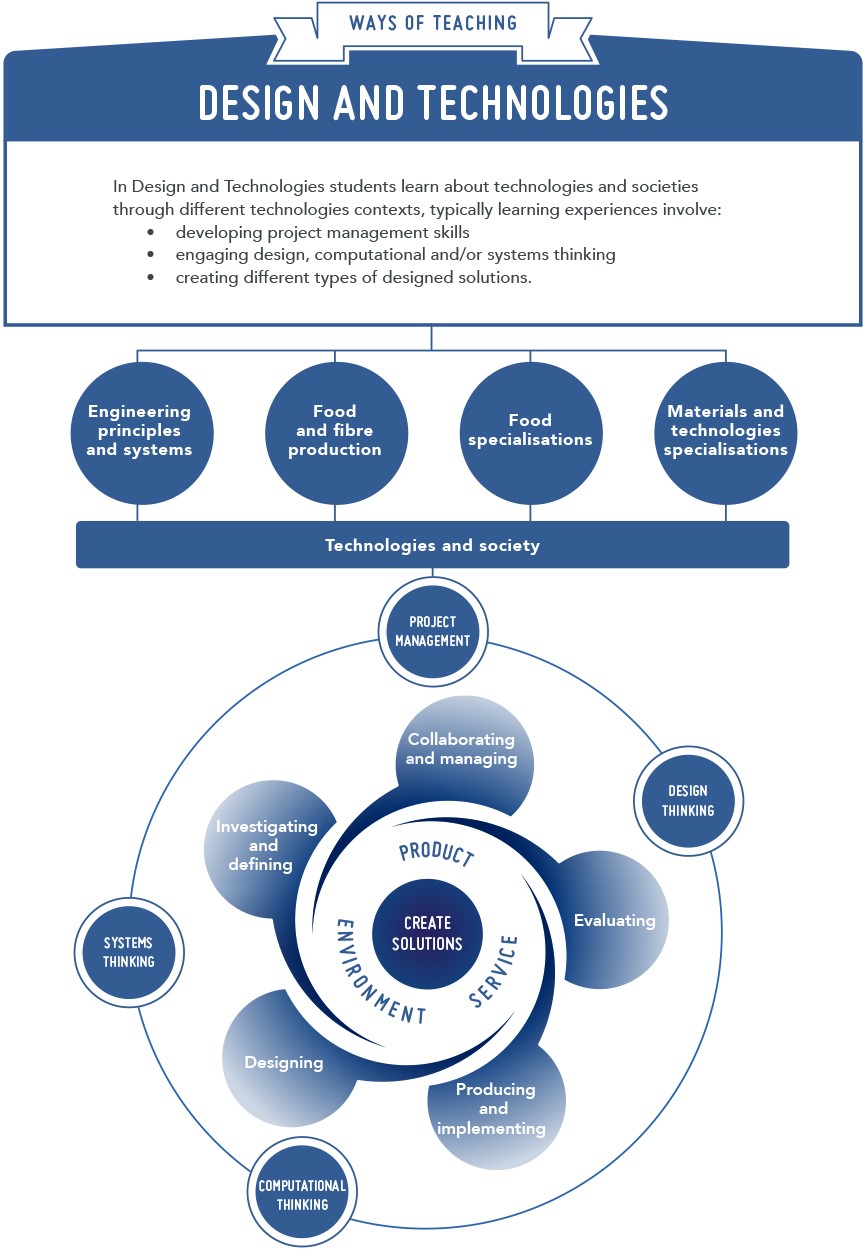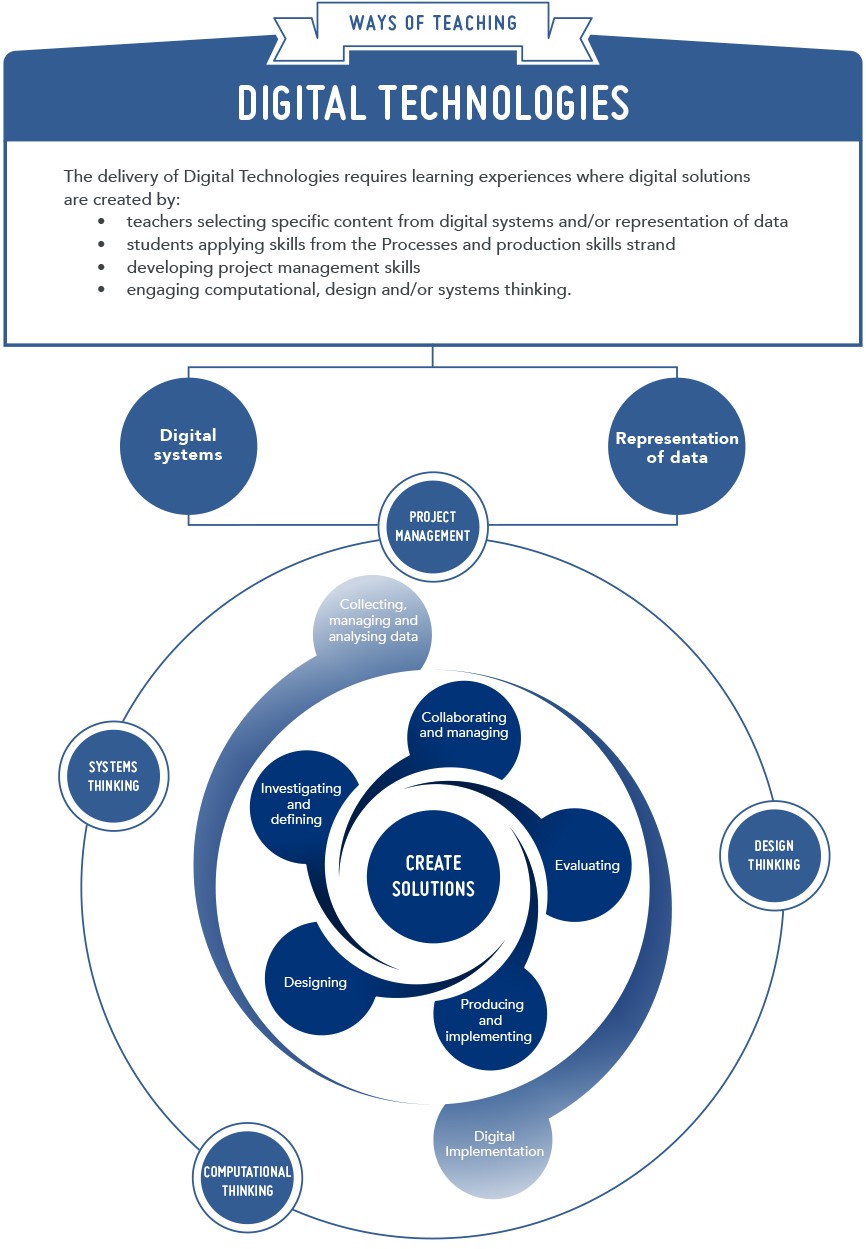Ways of Teaching
The 'ways of teaching' aim to support teachers with planning for curriculum delivery across the years of school, with the teaching in each year extending learning in previous years.
The 'ways of teaching' complement the principles of teaching and learning in the Western Australian Curriculum and Assessment Outline (http://k10outline.scsa.wa.edu.au/). The principles focus on the provision of a school and class environment that is intellectually, socially and physically supportive of learning. The principles assist whole-school planning and individual classroom practice.
The Technologies learning area is made up of two distinct subjects Design and Technologies and Digital Technologies. The content is presented through the interrelated strands of Knowledge and understanding and Processes and production skills. The strands are different in each subject; with common threads to allow for integration between the Technologies subjects. Knowledge and understanding is taught in combination with the processes and production skills.
The teaching of Technologies requires learning experiences which allow students to:
- develop systems, design and computational thinking
- create digital solutions
- create product, service and environment designed solutions.
Design and Technologies
In Design and Technologies students learn about technologies and societies through different technologies contexts. In each year students will be given opportunities to create designed solutions in at least one of the technologies contexts below:
- Engineering principles and systems – in this context the focus is on how forces can be used to create light, sound, heat, movement, control or support in systems
- Food and fibre production – in this context the focus is on the process of producing food or fibre as natural materials for the design and development of a range of products. Fibre includes materials from forestry (Food and fibre production includes Food specialisations from Pre-primary to Year 4)
- Food specialisations – in this context the focus is on the application of nutrition principles and knowledge about the characteristics and properties of food to food selection, preparation; and contemporary technology-related food issues
- Materials and technologies specialisations – in this context the focus is on a broad range of traditional, contemporary and emerging materials and specialist areas that typically involve extensive use of technologies, this includes materials such as, textiles, metal, wood and plastics.
Digital Technologies
Digital Technologies is a subject that has a specific curriculum and includes the practical application of the ICT general capability.
In Digital Technologies, students develop an understanding of the characteristics of data, digital systems, audiences, procedures and computational thinking. They apply this when they investigate, communicate and create digital solutions.
The ICT capability involves students in learning to make the most of the technologies available to them, adapting to new ways of doing things as technologies evolve, and limiting the risks to themselves and others in a digital environment.
The clear difference between the Digital Technologies curriculum and the ICT general capability is that the capability helps students to become effective users of digital technologies while the Digital Technologies curriculum helps students to become confident developers of digital solutions.
In the primary years, the Technologies subjects are often interrelated and connected through other learning areas. When programming, teachers can use the Technologies learning area as a basis for the practical application and development of concepts from other learning areas. For example, students' mathematical ability to solve problems involving linear equations can be used in Technologies when investigating quantitative relationships and designing algorithms.
In the secondary years, Technologies is typically a specialist area, with both subjects and each of the contexts taught by specialist teachers.
When developing teaching and learning programs:
- the teacher identifies the prior knowledge of students to establish a starting point for the learning
- the teacher defines the subject and context for the learning experience with reference to the content descriptions. (For example, Design and Technologies – Food and fibre production)
- the teacher and students identify the problem, situation or need that requires a solution, considering resources available.
Teachers generate meaningful learning activities to facilitate creating solutions, for example, students:
- reflect on actions to refine working processes and develop decision making skills
- evaluate how well systems and/or products meet current and future sustainability needs
- manage collaborative projects
- apply appropriate social, ethical and technical protocols
- use a range of delivery modes such as audio, visual and practical
- develop skills to produce solutions to problems
- investigate emerging technologies
- identify 'real world problems'
- investigate 'problem, situation or needs' for which to find a solution
- engage in experiences that are transferable to family and home, community contribution and the world of work
- use critical and creative thinking to weigh up possible short and long term impacts
- reflect upon existing designs to source ideas for future solutions
- play and experiment with technologies to investigate possible solutions.
For information on how to collect evidence to inform planning for ongoing learning experiences in Technologies refer to 'Ways of Assessing'.

 Technologies Scope and Sequence
Technologies Scope and Sequence
